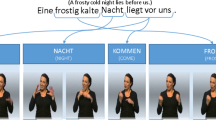Abstract
We propose a trajectory planning and control theory which provides explanations at the computation, algorithm, representation, and hardware levels for continuous movement such as connected cursive handwriting. The hardware is based on our previously proposed forward-inverse-relaxation neural network. Computationally, the optimization principle is the minimum torque-change criterion. At the representation level, hard constraints satisfied by a trajectory are represented as a set of via-points extracted from handwritten characters. Accordingly, we propose a via-point estimation algorithm that estimates via-points by repeating trajectory formation of a character and via-point extraction from the character. It is shown experimentally that for movements with a single via-point target, the via-point estimation algorithm can assign a point near the actual via-point target. Good quantitative agreement is found between human movement data and the trajectories generated by the proposed model.
Similar content being viewed by others
References
Edelman S, Flash T (1987) A model of handwriting. Biol Cybern 57:25–36
Edelman S, Ullman S, Flash T (1990) Reading cursive handwriting by alignment of letter prototypes. International Journal of Computer Vision 5(3):303–331
Flash T, Hogan N (1985) The coordination of arm movements: an experimentally confirmed mathematical model. J Neurosci 5:1688–1703
Hoff B, Arbib MA (1993) Models of trajectory formation and temporal interaction of reach and grasp. J Motor Behav 25:175–192
Hoffman J, Skrzypek J, Vidal JJ (1993) Cluster network for recognition of handwritten, cursive script characters. Neural Networks 6:69–78
Hollerbach JM (1981) An oscillation theory of handwriting. Biol Cybern 39:139–156
Jordan MI (1989) Indeterminate motor skill learning problems. In: Jeannerod M (eds) Attention and performance, XIII. MIT Press, Cambridge, Mass. 796–836
Kawato M (1992) Optimization and learning in neural networks for formation and control of coordinated movement. In: Meyer DE, Kornblum S (eds) Attention and performance XIV. MIT Press, Cambridge, Mass. pp 821–849
Kawato M (1994) Unidirectional versus bi-directional theory for trajectory planning and control. (ATR Technical Reports, TR-H-068, March 31) In: Hida, T (ed) Mathematical approach to fluctuations. World Science, Singapore
Kawato M (1995) Trajectory formation in arm movements: minimization principles and procedures. In: Zelaznik HN (eds) Advances in motor learning and control. Human Kinetics Publishers, Champaign (in press)
Kawato M, Maeda Y, Uno Y, Suzuki R (1990) Trajectory formation of arm movement by cascade neural network model based on minimum torque-change criterion. Biol Cybern 62:275–288
Kawato M, Grandolfo F, Gomi H, Wada Y (1994) Teaching by showing in kendama based on optimization principle. Proceeding of International Conference on Artificial Neural Networks, May 26–29, Sorrento, Italy, pp 601–606
Marr D (1982) Vision. Freeman, New York
Massone L, Bizzi E (1989) A neural network model for limb trajectory formation. Biol Cybern 61:417–425
Morasso P, Mussa-Ivaldi FA (1982) Trajectory formation and handwriting: a computational model. Biol Cybern 45:131–142
Nakamura M, Uno Y, Suzuki R, Kawato M (1990) Formation of optimal trajectory in arm movement using inverse dynamics model. (Japan IEICE Technical Report, NC89-63) (in Japanese)
Poggio T, Torre V, Koch C (1985) Computational vision and regularization theory. Nature 317:314–319
Rumelhart DE (1993) Theory to practice: a case study recognizing cursive handwriting. In: Baum EB (eds) SIAM Frontier Series. Philadelphia, pp 177–196
Uno Y, Kawato M (1994) Dynamic performance indices for trajectory formation of human arm. (ATR Technical Reports, TR-H-071, March 31)
Uno Y, Kawato M, Suzuki R (1989a) Formation and control of optimal trajectory in human arm movement — minimum torque-change model. Biol Cybern 61:89–101
Uno Y, Suzuki R, Kawato M (1989b) Minimum muscle-tension-change model which reproduces human arm movement. Proceedings of the 4th Symposium on Biological and Physiological Engineering pp 229–302 (in Japanese)
Wada Y, Kawato M (1993) A neural network model for arm trajectory ormation using forward and inverse dynamics models. Neural Networks 6:919–932
Wada Y, Koike Y, Vatikiotis-Bateson E, Kawato M (1995) A computational theory for movement pattern recognition based on optimal movement pattern generation. Biol Cybern 73:15–25
Author information
Authors and Affiliations
Rights and permissions
About this article
Cite this article
Wada, Y., Kawato, M. A theory for cursive handwriting based on the minimization principle. Biol. Cybern. 73, 3–13 (1995). https://doi.org/10.1007/BF00199051
Received:
Accepted:
Issue Date:
DOI: https://doi.org/10.1007/BF00199051




